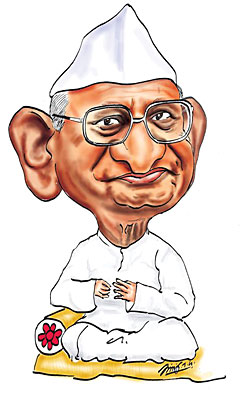 |
NEW DELHI -- Five years ago, Nepalis made their own tryst with destiny when they mounted a Jana Andolan to force an absolute monarch to restore parliament and install a democratic government.
Since that peaceful people's movement from the streets, Nepal has seen four prime ministers in four years. As yet another prime minister resigns in Kathmandu this week, bemused Nepalis must be looking across the border to the snowballing anti-corruption street protests in India.
New Delhi is witnessing its own Jana Andolan of sorts. A 77-year-old Gandhian, Anna Hazare, announced he would fast unto death to protest corruption and black money. He was not just prevented from doing so but put behind bars. As the political establishment ordered a crackdown on the ageing activist, a wave of revulsion has swept the country.
For the first time in seven years that it has ruled India, the Congress-led United Progressive Alliance (UPA) coalition is looking nervous. It's no longer about Anna's blackmail tactics (he has threatened to go on hunger strike until his group's version of a bill for creating
the institution of an ombudsman or Lokpal is accepted by the government) or about the fact that Hazare's 'movement' is restricted to a few thousand people. The issue has opened up a debate on whether civil society activists have the right to challenge parliament's exclusive privilege to make a bill.
If Team Anna, as Anna's people un-selfconsciously describe themselves, allow a vote to be taken on their bill, they might find to their surprise that there aren't many takers. Wearing a khadi cap and calling yourself a Gandhian hardly squares with implicit threats of blackmail.
But here's the thing: by disallowing Anna and his people to protest peacefully, limiting the number of people who could participate in the protest as well as limiting the number of days for which the protest was allowed, the Manmohan Singh government overplayed its hand.
The people wanted reassurance, they got a lathi charge. The people wanted the government to take action against the guilty and promise good governance. Several politicians and corporates were, indeed, thrown into jail, but it turned out the rot was deeper. On the backfoot, the government hoped to turn the tables.
Only, it has ended up with egg on its face. Whether or not Anna Hazare wins the right to fast as long as he likes in Ramlila Maidan, the fact is that the UPA government has never looked weaker.
There is no comparison between Anna Hazare's people and Nepal's Jana Andolan in April 2006. At the time in Kathmandu, there was a genuine outpouring of the people on the streets. Many tyres were burnt and the protests continued into the early hours of the night. Interestingly, the underground Maoists, who controlled the heart of the protests also ensured discipline. What the Maoists could not achieve in ten years of war was attained in three weeks of peaceful street protests.
That is why the democratic experiment, as it slowly implodes in Nepal, is almost too much to bear. There was so much promise in 2006, but it seems to have been frittered away by a combination of short-sightedness and overarching partisan and personal ambition. Although not in the same scale as in India, rampant corruption is also the focus of protests in Kathmandu as Nepalis organise Facebook rallies against malfeasance.
Is an all-party government the answer? Why can't Nepal's political parties get together and write a constitution? After all, that's what India's Constituent Assembly did for nearly three years after 1947, and its members weren't even elected by the people, unlike in Nepal.
The likes of Anna Hazare can never become a challenge to an elected government in India. But just because he can't, doesn't mean that Delhican be dismissive about the yearnings of the people for clean and transparent government.
That's a lesson for both Nepal and India. In a democracy, you can't afford to take the people for granted.
Read also:
Descent into dystopia, EDITORIAL
All for one, one for all, KIRAN NEPAL



